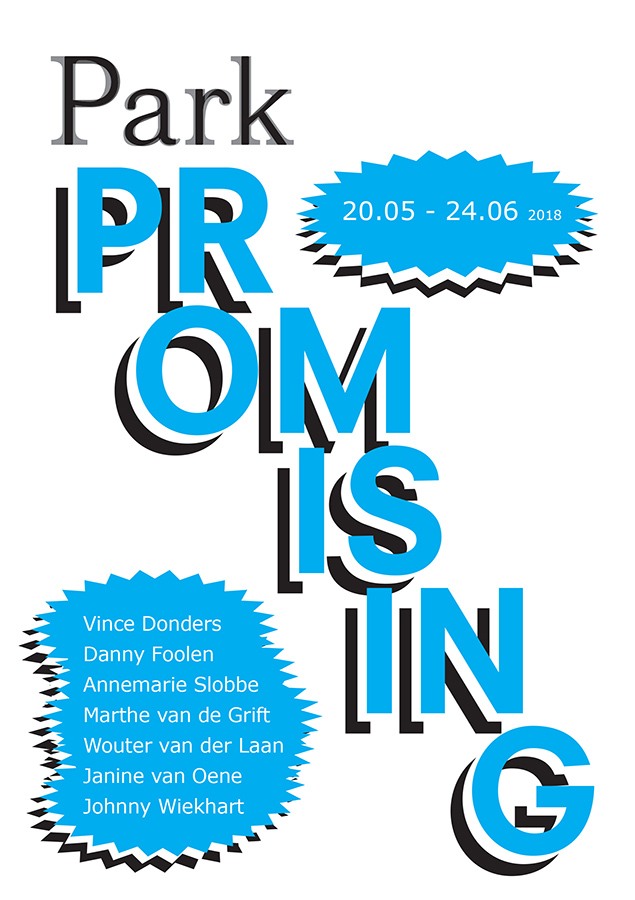
Vince Donders (NL)
Danny Foolen (NL)
Annemarie Slobbe (NL)
Marthe van de Grift (NL)
Wouter van der Laan (NL)
Janine van Oene (NL)
Johnny Wiekhart (NL)
With the exhibition Promising, PARK pays attention to the tenth anniversary of Kunstpodium T and the long-term Apprentice Master project. Under the guidance of about 150 masters, more than 500 talents have showed their work over ten years. For PARK this has been the reason to subjectively select seven very promising artists and give them a platform.
Opening on Saturday, May 19 at 4pm. It will be performed by Jeroen Bosch, founder and chief editor of Trendbeheer.
Rebecca Nelemans wrote the following text for the exhibition: If there is a common denominator in the exhibition, it is that of the investigative and sensing attitude of the young makers. In search of individuality they take nothing for granted, and certainly not art. This is clearly a generation of artists who grew up with the modern dogma of manufacturability. They contrast it with the simple and vulnerable 'being'.
The work of Vince Donders (1991) recalls both the engravings of Giovanni Battista Piranesi and the dark film decor of Blade Runner. He shows us an ominous and macabre vision of the future: it is dark, dirty, dilapidated and extinct. This is still quite illustrative in his drawings, but the installations with wood, technological waste material and dripping tar become increasingly abstract and difficult to interpret. Donders gives us a poignant way of how we shape the world of tomorrow.
Danny Foolen (1985) questions the 'space' given in installations with scale models and photographic material. He stacks fragments of scale models (large) in a room to defy gravity, or stops (small) in a box as stored possibilities for later. He places reconstructions of angles inverted in the same angle, or in another one, and thus makes us aware of the space in which we find ourselves and which we usually hardly consciously perceive.
The way in which we are attached to a certain vase or candlestick and how we give it a place in our interiors, that is what Janine van Oene (1988) is surprised about. In powerful but sensual brushstrokes she is inspired for this exhibition by the phenomenon of 'fountain': it is an architectural and at the same time decorative sculptural form, which we see in all sorts of cultures in both private gardens and public squares.
Annemarie Slobbe (1990) works from attention on concepts such as 'infinity', 'emptiness', 'space' and 'time'. The viewer gets to see an almost cinematic movement that turns digital when he or she changes position. Closer to it, however, one discerns that the work has been accomplished meticulously with small brush strokes or pencil strokes, while the artist followed the material without giving it guidance.
Marthe van de Grift (1990) works from a childlike wonder: "How certain things are so logical to us, just because we do not think about it anymore." She challenges the viewer to a game with stubborn thinking patterns by using a different point of view, another 'dealing with’. So she tries to "crumble the hard foundations of our intellect a little bit."
Wouter van der Laan (1993) quickly extended the simple action of a brush stroke with oil paint to acrylic paint, spray paint, sawing wood, drawing, printing and the use of everyday objects. In this way he creates a huge amount of material from which he composes an installation in collage-like fashion with each exhibition. As if again and again - and in a continuous stream of visual thinking - he has to reinvent for himself what a work of art is, or when a composition is successful.
Johnny Wiekhart (1994) is also at the boundary between two- and three-dimensional work: his paintings become reliefs on the wall, then come off the wall and become objects. The newest step is that of movement and thus time. In this time - in which we get the feeling that everything is feasible and within reach through the internet - a kind of digital shadow forms a person's identity. Facing that everyday surreality, Wiekhart places concrete abstractions in which he examines the tangible qualities of materiality.
Click here for the exhibition guide.
In the media: